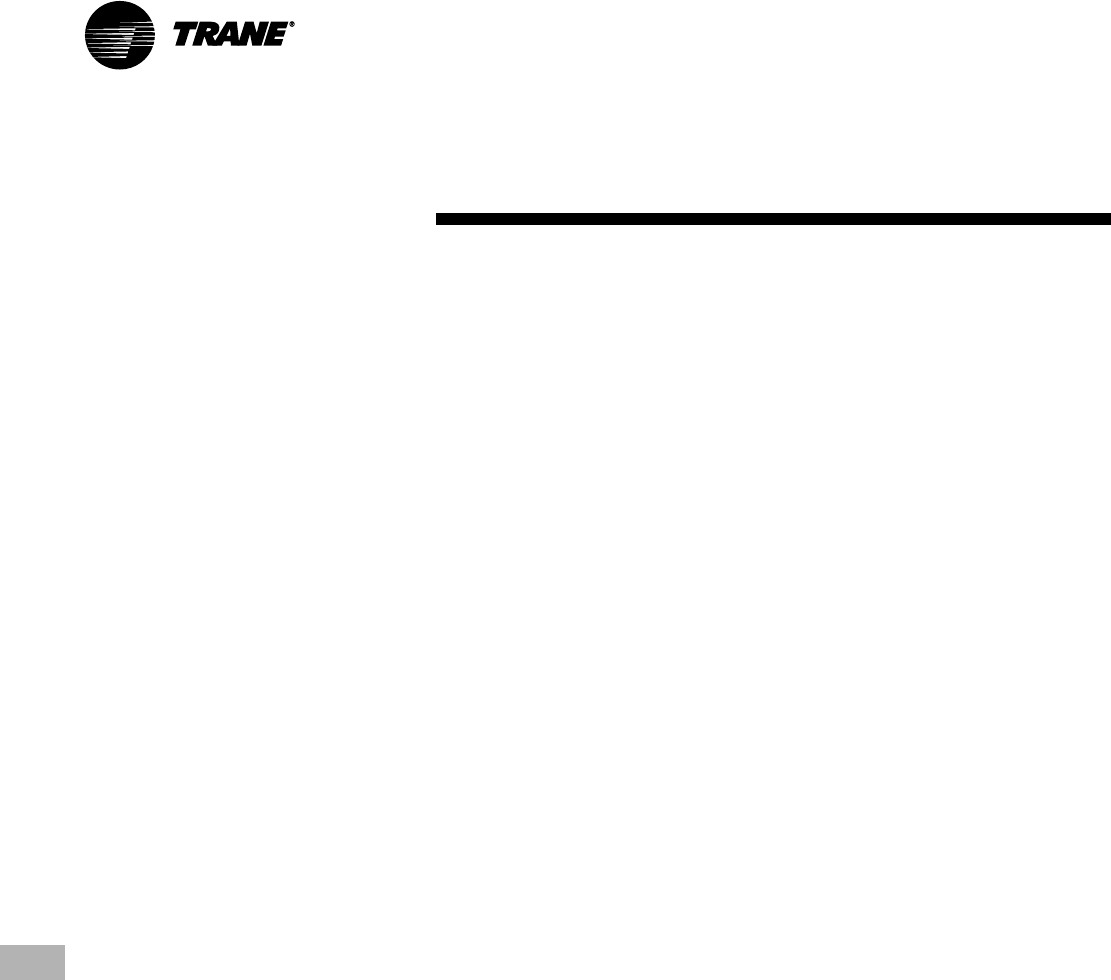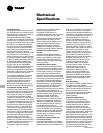
Mechanical
Specifications
PKG-PRC002-EN98
Options
Airside Economizer
Units with the airside economizer option
are equipped with the necessary control
sequences to use outside air for the first
stage of cooling, in occupied or
unoccupied mode and when ambient
conditions are favorable for economizing.
Inherent in the unit controller is the ability
to suppress the setpoint below the normal
unit setpoint. This allows the building to
improve comfort levels when possible,
and at the same time, optimize building
mechanical cooling operation for peak
operating efficiency. An outside air
temperature and relative humidity sensor
are provided to allow monitoring of
reference enthalpy and are field installed.
Economizer operation enables when the
outside air enthalpy is less than 25 BTU’s/
lb. default (adjustable 19-28 BTU’s/lb.).
During occupied mode, the outside air
damper opens to 15% (adjustable 0-
100%) for ventilation purposes. Also, the
ability to alter the outside air damper
position to compensate for VAV supply air
modulation is inherent in the unit controls,
and can be enabled by the operator.
The mixing box fabrication is 16-gauge
galvanized steel. Opposed low leak
damper blades are fabricated from 16-
gauge galvanized steel and rotate on
rustproof nylon bushings. A factory
installed 24V modulating spring return
actuator controls both damper positions.
• Comparative Enthalpy Control
Units with comparative enthalpy control
are equipped with the necessary control
sequences to allow using outside air for
the first stage of cooling, in occupied or
unoccupied mode and when ambient
conditions are favorable for economizing.
Inherent in the unit controller is the ability
to suppress the setpoint below the normal
unit setpoint. This allows the building to
improve comfort levels when possible,
and at the same time, optimize building
mechanical cooling operation for peak
operating efficiency. A factory-installed
control board, with field-installed outside
and return air temperature and relative
humidity sensors, allows monitoring of
outside and return air. Economizer
operation enables when the outside air
enthalpy is 3 BTU’s/lb. less than the return
air enthalpy. During occupied mode, the
outside air damper opens to 15%
(adjustable 0-100%) for ventilation
purposes. Also, the ability to alter the
outside air damper position to
compensate for VAV supply air
modulation is inherent in the unit controls,
and can be enabled by the operator.
The mixing box fabrication is 16-gauge
galvanized steel. Opposed low leak
damper blades are fabricated from 16-
gauge galvanized steel and rotate on
rustproof nylon bushings. A factory
installed 24V modulating spring return
actuator controls both damper positions.
•Standard Two-Position Damper
Interface
Units with the two-position damper
interface are provided with a 0-10 VDC
control output suitable for controlling a
field-provided modulating actuator. In
occupied mode, the output drives to the
maximum position.
• Airside Economizer Interface
Units with airside economizer interface
are equipped with the necessary control
sequences to allow using outside air for
the first stage of cooling, in occupied or
unoccupied mode and when ambient
conditions are favorable for economizing.
Inherent in the unit controller is the ability
to suppress the setpoint below the normal
unit setpoint. This allows the building to
improve comfort levels when possible,
and at the same time, optimize building
mechanical cooling operation for peak
operating efficiency. An outside air
temperature and relative humidity sensor
are provided for field installation to
monitor reference enthalpy. Economizer
operation enables when the outside air
enthalpy is less than 25 BTU’s/lb.
(adjustable 19-28 BTU’s/lb). During
occupied mode, the outside air damper
opens to 15% (adjustable 0-100%) for
ventilation purposes. Also, the ability to
alter the outside air damper position to
compensate for VAV supply air
modulation is inherent in the unit controls,
and can be enabled by the operator. An
analog 2-10 VDC output (adjustable (0-10
VDC) is provided to modulate the field-
provided 30 second damper actuators
(adjustable 1-255 seconds).
• Airside Economizer Interface with
Comparative Enthalpy
Units with airside economizer interface
and comparative enthalpy are equipped
with the necessary control sequences to
allow using outside air for the first stage
of cooling, in occupied or unoccupied
mode and when ambient conditions are
favorable for economizing. Inherent in the
unit controller is the ability to suppress
the setpoint below the normal unit
setpoint. This allows the building to
improve comfort levels when possible,
and at the same time, optimize building
mechanical cooling operation for peak
operating efficiency. A factory-installed
control board, with outside and return air
temperature and relative humidity
sensors, are provided for monitoring
outside and return air. The sensors are
field installed. Economizer operation
enables when the outside air enthalpy is
3 BTU’s/lb. less than the return air
enthalpy. During occupied mode, the
outside air damper opens to 15%
(adjustable 0-100%) for ventilation
purposes. Also, the ability to alter the
outside air damper position to
compensate for VAV supply air
modulation is inherent in the unit
controls, and can be enabled by the
operator. An analog 2-10 VDC output
(adjustable (0-10 VDC) is provided to
modulate the field-provided 30-second
damper actuators (adjustable 1-255
seconds).
Basic Water Piping
This option is available on units without a
waterside economizer and with
condenser water applications above 54 F
(12.2 C) that do not require condensing
pressure control. Left hand water
connections and piping are extended to
the unit exterior. Manifold piping is
factory installed.
Intermediate Water Piping
This option provides condensing
temperature control when the unit is
configured (user defined at the HI) for
variable water flow with or without a
waterside economizer. A two-way
modulating control valve is wired and
installed in the unit to maintain a specific
range of water temperature rise through
the condenser when entering fluid
temperature is less than 58 F (15 C). This
option allows the compressor to operate
with entering fluid temperature down to
35 F (2 C). The minimum valve position to
maintain minimum condenser flow rates
is user-defined at the human interface.
This valve drives closed if the unit shuts
down or if a power failure occurs.


















